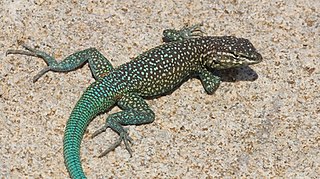
The Phrynosomatidae are a diverse family of lizards, sometimes classified as a subfamily (Phrynosomatinae), found from Panama to the extreme south of Canada. Many members of the group are adapted to life in hot, sandy deserts, although the spiny lizards prefer rocky deserts or even relatively moist forest edges, and the short-horned lizard lives in prairie or sagebrush environments. The group includes both egg-laying and viviparous species, with the latter being more common in species living at high elevations.
Side-blotched lizards are lizards of the genus Uta. They are some of the most abundant and commonly observed lizards in the deserts of western North America, known for cycling between three colorized breeding patterns and is best described in the common side-blotched lizard. They commonly grow to 6 inches including the tail, with the males normally being the larger sex. Males often have bright throat colors.

The common side-blotched lizard is a species of side-blotched lizard in the family Phrynosomatidae. The species is native to dry regions of the western United States and northern Mexico. It is notable for having a unique form of polymorphism wherein each of the three different male morphs utilizes a different strategy in acquiring mates. The three morphs compete against each other following a pattern of rock paper scissors, where one morph has advantages over another but is outcompeted by the third.

Hypsiglena torquata, the night snake, is a species of rear-fanged colubrid. It is found in Mexico. It is characterized by dark brown systematic blotches down its back and sides, a bar behind each eye, vertical pupils, and neck adornment. It is active in the twilight and at night. It is not dangerous to humans.
Sceloporus arenicolus, the dunes sagebrush lizard, formerly known as the sand dune lizard and the dunes-sagebrush lizard, Sceloporus graciosus arenicolus, a subspecies of sagebrush lizard), is an insectivorous spiny lizard species which only occurs in the shinnery oak sand dune systems of extreme southeast New Mexico and only four counties in adjacent Texas. Sceloporus arenicolus has the second-smallest range of all lizards in the United States.
Isla Ballena, is an island in the Gulf of California east of the Baja California Peninsula. The island is uninhabited and is part of the La Paz Municipality.
Isla Danzante, is an island in the Gulf of California east of the Baja California Peninsula. The island is uninhabited and is part of the Loreto Municipality.
Isla San Ildefonso, is an island in the Gulf of California east of the Baja California Peninsula. The island is uninhabited and is part of the Mulegé Municipality.
Isla Coloradito is an island in the Gulf of California east of the Baja California Peninsula. The island is uninhabited and is part of San Felipe Municipality.
Isla San Lorenzo Sur, is an island in the Gulf of California east of the Baja California Peninsula. The island is uninhabited and is part of the Mexicali Municipality. Isla San Lorenzo Norte is located immediately northwest of Isla San Lorenzo Sur.
Isla San Luis is an island in the Gulf of California east of the Baja California Peninsula. The island is uninhabited and is part of the San Felipe Municipality.
Isla San Jerónimo, is an island in the Pacific Ocean on the west side of the Baja California Peninsula. The island is part of the large Ensenada Municipality and accessed from Punta Baja near the community of El Rosario, Baja California.
Isla San Martín is an island in the Pacific Ocean west of the Baja California Peninsula. The island is uninhabited and is part of the Ensenada Municipality.
The enchanted side-blotched lizard or San Lorenzo Island lizard is a species of lizard. Its range is in Mexico.
The dead side-blotched lizard is a species of lizard. Its range is in Mexico. The specific name, lowei, is in honor of American herpetologist Charles Herbert Lowe.
The San Pedro side-blotched lizard is a species of lizard. Its range is in Mexico.

The Isla Santa Catalina side-blotched lizard is a species of lizard. It is endemic to Isla Santa Catalina in the Gulf of California, Mexico. This species of lizard can be as long as 2.2 inches.




